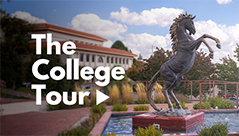Valerie DeLaCruz’s tightly knit ranching family thought that they could fend for themselves. That all changed about two years ago when both of DeLaCruz’s grandfathers approached the end of their lives within a few months of each other. Suddenly, DeLaCruz and her formerly independent family found themselves welcoming hospice workers into their homes.
“Hospice was just great to us,” said DeLaCruz, “They were amazing. They helped us mentally, physically. They helped with everything.” It was this experience that made DeLaCruz realize she wanted to be a social worker. “It was seeing that people do make a difference in families,” she explained. The experience made such an impression on her that she wrote an essay about it, “Rock Bottom,” that is soon to be printed in “The Maverick,” published by Mimbres Press of Western New Mexico University. Now in her second year in the WNMU BSW program, DeLaCruz is already making a difference in the world.
This year, she was awarded an internship with the BUILDing Scholars program in El Paso, an honor usually reserved for more experienced students. She spent her summer in the internship visiting shelters for unhoused people in El Paso and Ciudad de Juarez, where she helped distribute needed supplies through “dignity kits,” which have “all the essentials: toothbrushes, toothpaste socks, underwear, menstrual items—everything,” she said.
Her team also hosted a health fair that provided free healthcare services to the unhoused. “I had never seen anything like that,” said DeLaCruz, “It was a stress reliever for [the people in the shelter] to be able to have some services for themselves.”
While in El Paso for the internship, she also completed two large projects, one using a qualitative research method called Photovoice and a second sponsored by a non-profit organization. For the first project, DeLaCruz chose to focus on the struggles that students with Type 1 diabetes face in school, a topic inspired by her nephew, who has Type 1 diabetes. Following the Photovoice method, she used a series of ten photographs—for example of her nephew, his support team, and his insulin pump—and constructed a narrative around them based on interviews and personal observation. The method is designed to translate experience into knowledge that can be acted upon. “It really opened your mind to think about photos in a different way,” she said.
For the second project, DeLaCruz decided to take action to improve life in her hometown of Elfrida, AZ. As part of the $100 Solution, she was given $100 by the organization to jump-start a solution to a social problem of her choice. Said de la Cruz, “The $100 Solution is a nonprofit [that gives you] $100, and you go out into your community and find a situation you want to act on, and if the [money] is not enough to act on the situation, you partner with other foundations.” DeLaCruz decided to create menstruation kits to distribute to Elfrida high school and middle school students. When she had exhausted the initial $100, she reached out to OM Technologies Veterans Employment to secure ongoing funding. DeLaCruz was not just successful at getting the foundation on board, she also convinced her funders to commit to continue the program. “I did one hundred kits for the schools,” she said, “and the foundation that I partnered with is going to sustain [the program] for five more years.” DeLaCruz said that she was delighted by how the project turned out. “I was super happy to do it because that’s my hometown,” she said, “I want to help them . . . That’s why I am getting my degree. I want to go back home [and] do things for my community.”


